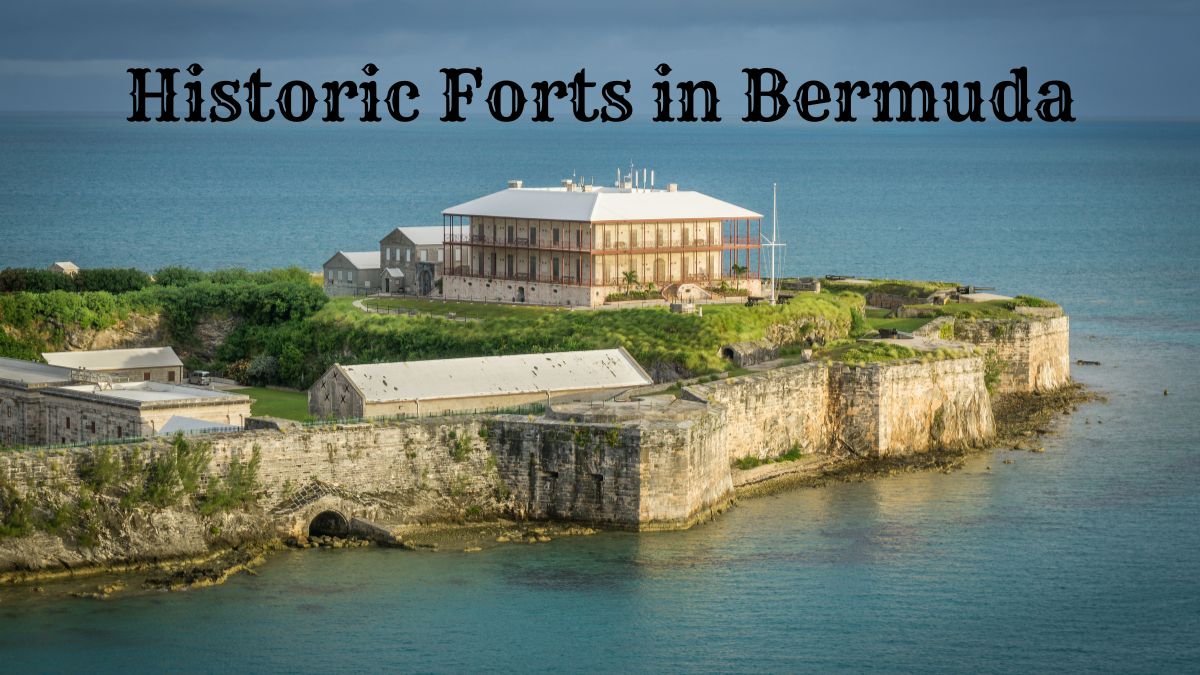Bermuda’s history is deeply intertwined with its military architecture, notably its collection of historic forts. Scattered across the island’s coastline, these fortifications have guarded the North Atlantic since the early 17th century.
Designed to protect the island from potential Spanish invasions, the forts of Bermuda are an integral part of the island’s colonial legacy. The forts vary in size and complexity, but they all share a common purpose: defense.
They were strategically placed to provide overlapping fields of fire, and many were constructed at high vantage points to spot enemies from afar.
Over the years, these fortresses have withstood the test of time and elements, preserved as cultural landmarks that offer insight into Bermuda’s past.
Today, these sites are open-air museums and testimonies to the island’s military significance during colonial times.
Tourists and historians alike can explore battlements, gun emplacements, and the architecture that once made Bermuda one of the most fortified places in the world.
Each fort’s silent cannons and sturdy ramparts echo stories of bygone eras, providing a tangible connection to the island’s military heritage.
The History of Bermuda’s Fortifications
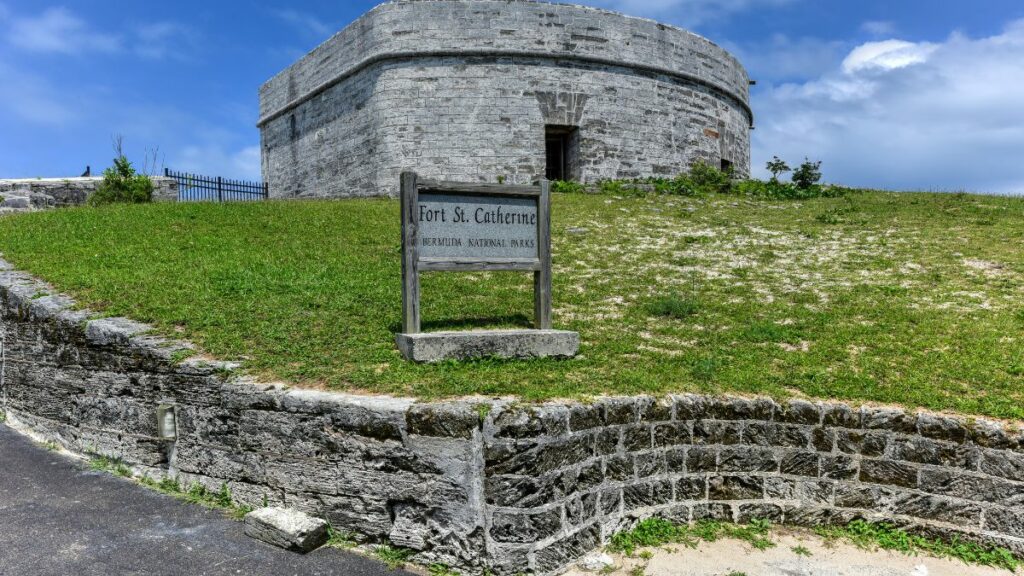
Bermuda’s forts are historic sentinels, relics of the island’s strategic military past tied to Britain and its Royal Navy.
These defensive structures are treasures for history enthusiasts and have been symbols of the island’s resilience and protective strategies for centuries.
Early Beginnings and Strategic Importance
The history of Bermuda’s fortifications begins with the accidental arrival of the Sea Venture in 1609. This event sparked British interest in the island, leading to its settlement and fortification.
Governor Richard Moore, Bermuda’s first governor, laid the framework for an extensive fortification strategy in 1612.
Recognizing the island’s crucial positioning between British colonies and Europe, Moore understood the significance of safeguarding against potential Spanish or French threats and, later, American invasion during the American Revolution.
Development Through the Centuries
As the island’s importance grew, so did the scale and sophistication of its fortifications.
Throughout the 17th and 18th centuries, Bermuda saw continued military development to protect the Royal Navy’s Western Atlantic headquarters.
By the 19th century, during the Duke of Wellington’s tenure, the British military significantly upgraded Bermuda’s fortifications.
Notably, the construction of Fort Hamilton incorporated the latest advancements with formidable 18-ton guns, representing the peak of the island’s military development.
Bermuda’s historical fortifications have endured through centuries and become recognized as a World Heritage Site, honoring their significance in military history and the story of Britain’s global defense network.
Major Historic Forts in Bermuda
Bermuda’s strategic Atlantic location has led to a significant military presence, with a rich history embodied in its numerous historic forts.
These fortifications, several of which are well-preserved, offer insights into the island’s past as a bastion of defense.
Fort George
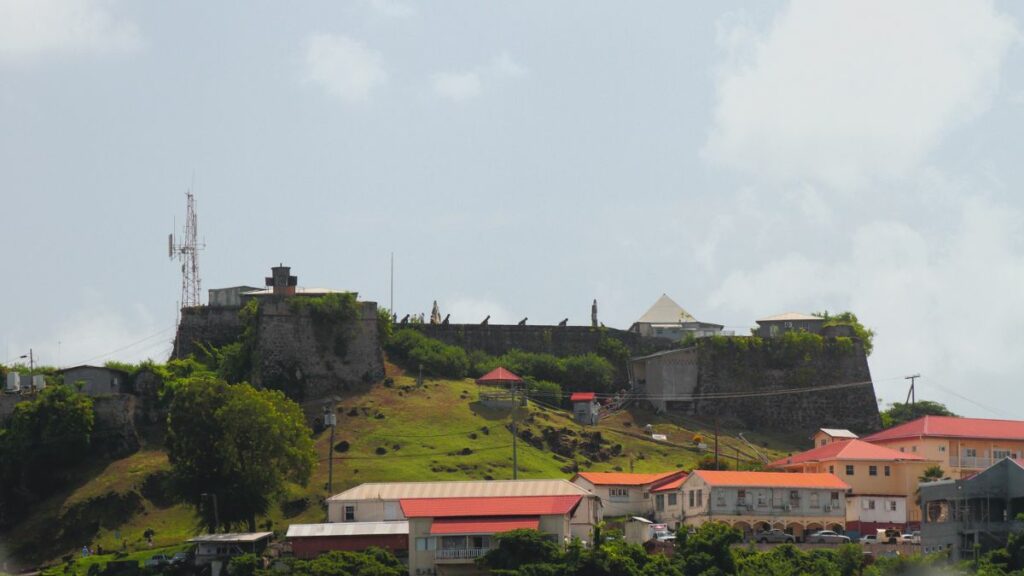
Fort George, perched on a hill overlooking the town of St. George and the sea, is a historic fortification in Bermuda. Constructed in the early 17th century, the fort was named after King George III.
It was part of the island’s extensive coastal defense system, designed to protect against foreign invasions and pirate attacks.
The fort’s elevated position provided a strategic advantage, allowing for surveillance of both land and sea approaches.
Fort George was equipped with numerous cannons and other military hardware to defend the island’s eastern end. The fort’s garrison monitored shipping activities and provided a first line of defense.
Fort George in the Context of Global Conflicts
Throughout its operational history, Fort George played a role during various global conflicts, including the American War of Independence and the two World Wars.
Although the fort never saw direct combat, it remained an active military site, adapting to the changing needs of warfare and technology over the centuries.
Preservation of Fort George
After being decommissioned as a military site, Fort George has been preserved as a historical monument.
The fort’s structures, including barracks, gunpowder magazines, and artillery placements, have been maintained, allowing visitors to step back in time and explore the island’s military heritage.
Modern-Day Attraction and Educational Site
Now a popular tourist attraction, Fort George offers guided tours and educational displays that recount its history and significance.
The site provides an opportunity to learn about Bermuda’s role in strategic defense and the evolution of military architecture.
In addition to its historical value, Fort George is renowned for its panoramic vistas. Visitors can enjoy breathtaking views of St. George’s Harbour and the surrounding landscapes.
The fort’s location makes it an ideal spot for photography, sightseeing, and appreciating the natural beauty of Bermuda.
Fort St. Catherine
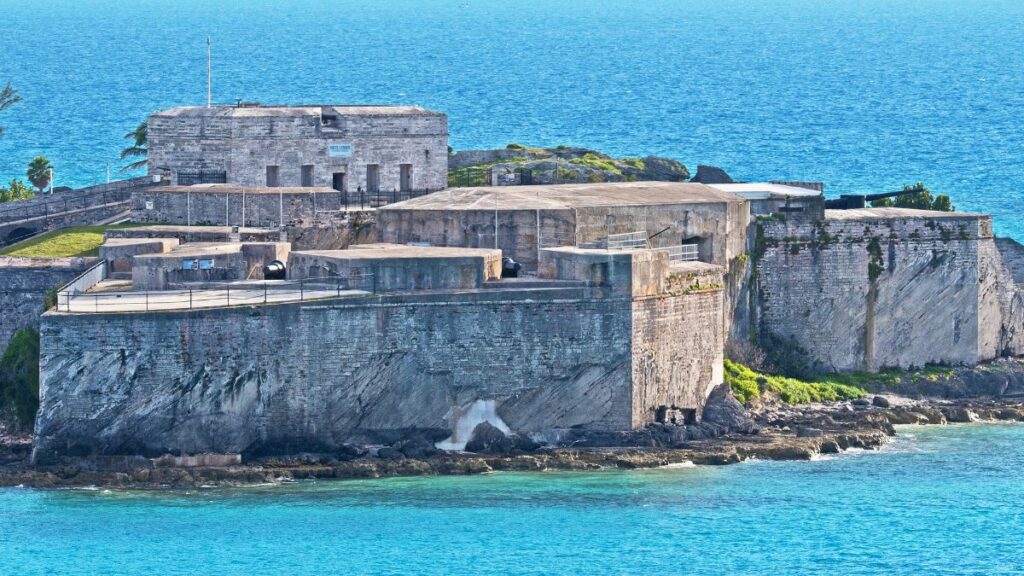
Fort St. Catherine’s roots reach back to the early 17th century, established in 1614.
The fort is one of Bermuda’s most ancient military structures, having witnessed several reconstructions, particularly a major one in the 19th century that significantly altered its appearance and capabilities.
Throughout its history, the fort has been a linchpin in Bermuda’s defensive strategy. During the early settlement period, its strategic location was crucial for safeguarding the island from threats, playing a central role in the colony’s survival and security.
In contemporary times, Fort St. Catherine has been transformed into a museum, serving as a cultural hub that educates visitors on Bermuda’s military past.
The museum is home to many artifacts, offering insights into the fort’s history and the daily lives of the soldiers once garrisoned there.
Replica of the British Crown Jewels
The museum proudly displays exquisite replicas of the British Crown Jewels, providing a touch of regal splendor and allowing visitors to experience the majesty of these ceremonial objects far from their original home in the Tower of London.
Legend of ‘George the Ghost’
The fort is shrouded in local lore, with the tale of ‘George the Ghost’ adding a mysterious dimension to its historical narrative.
This legend captivates visitors, blending the fort’s tangible past with intangible myths and stories passed down through generations.
Fort Hamilton

Built in the 1870s, Fort Hamilton was erected in Pembroke Parish to defend Hamilton Harbour. This mid-19th-century structure was part of a broader strategy to protect against potential maritime threats, particularly from the United States.
The fort was engineered with formidable defensive features, including a surrounding moat and a network of underground passages. These elements were designed to fortify the structure against attacks and invasions that never came to pass.
A Peaceful Haven: Fort Hamilton Today
Despite its original purpose as a military installation, Fort Hamilton never engaged in active combat.
It has since been repurposed as a public space known for its lush gardens and its sweeping views of Hamilton Harbour, making it a popular spot for locals and tourists seeking tranquility and natural beauty.
Cultural Attractions and Events
Fort Hamilton seamlessly integrates its military past with present-day cultural events. Among the most notable attractions are the summer performances by the Bermuda Isles Pipe Band.
These events provide a unique experience, allowing visitors to enjoy traditional music within the fort’s historic walls.
Enjoying the Views: Scenic Panoramas
The fort’s strategic location on a hilltop served a military purpose, but it now allows visitors to enjoy breathtaking panoramic vistas of Hamilton Harbour.
The well-maintained gardens and walkways offer a picturesque setting for a stroll or a peaceful moment to take in the surroundings.
Scaur Hill Fort & Park
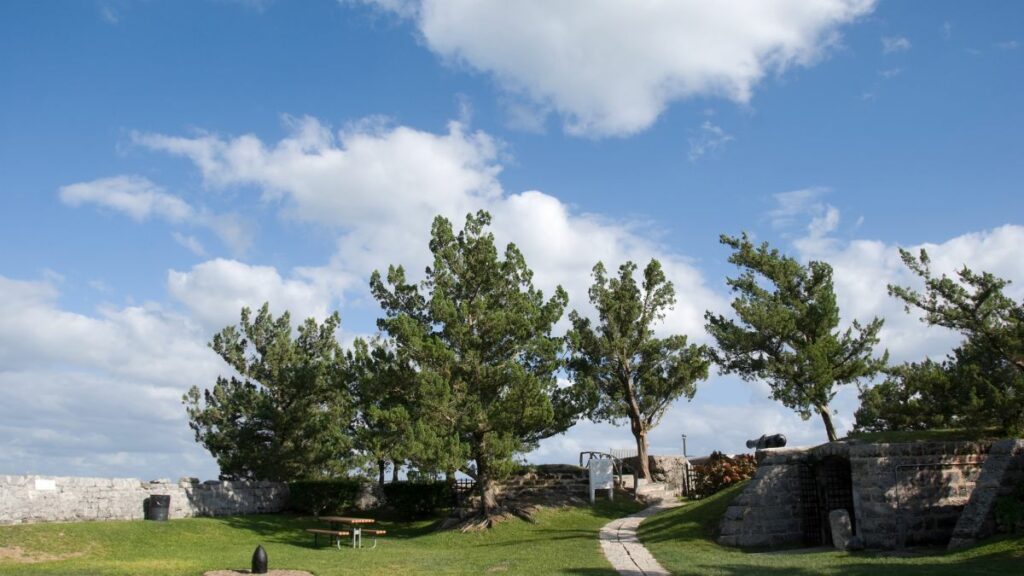
Scaur Hill Fort, situated within the lush Scaur Hill Park in Bermuda, was constructed in the late 19th century.
Its purpose was to protect the Royal Naval Dockyard and the western approaches to the island, particularly from the threat of American ships during times of tension.
The fort’s architecture boasts thick walls and strategic placement designed to house heavy artillery. These features were intended to deter naval forces from attacking Bermuda’s vital maritime interests.
Despite its formidable presence, Scaur Hill Fort, much like other Bermuda fortifications, never engaged in military action.
Scaur Hill Fort as a Public Park and Lookout Point
In the present day, Scaur Hill Fort & Park has been repurposed as a public space that offers more than just a glimpse into Bermuda’s military past.
The park is celebrated for its expansive views of the Great Sound and the surrounding areas, providing a perfect vantage point for sightseers and photographers alike.
Recreational Activities and Natural Beauty
Visitors to Scaur Hill Fort & Park can indulge in various recreational activities. The park’s trails and open spaces are ideal for picnics, leisurely walks, and family outings.
The area’s natural beauty and the fort’s historical significance make it a unique attraction for relaxation and exploration.
Preservation of History and Accessibility
The fort and park are an accessible historical site where visitors can learn about Bermuda’s strategic significance during the colonial era.
The preservation efforts allow for continued appreciation of the fort’s role in the island’s defense system while enjoying the peaceful park setting.
Scaur Hill Fort & Park exemplifies how historical military structures can be successfully integrated into modern recreational life.
The site offers a harmonious blend of the island’s history with the enjoyment of its natural beauty, making it a cherished location for both education and leisure.
Martello Tower

Martello Towers are small defensive forts built across the British Empire during the 19th century.
Named after a similar fortification at Mortella Point in Corsica, they were designed to serve as quick-fire stations for artillery, repelling enemy ships and deterring potential landings.
Typically, a Martello Tower is characterized by its round structure, thick walls, and a flat roof to mount a cannon that could rotate full circle.
The design was intended to withstand cannon fire and was often surrounded by a ditch or moat for additional protection.
These towers were usually two stories high, with the lower floor as a storage and living space and the upper floor as the gun platform.
Martello Towers in Strategic Locations
Martello Towers were strategically placed along coastlines, harbors, and riverbanks where an enemy approach was likely.
Their placement was a testament to the strategic thinking of the time, as they aimed to create a network of mutually supporting defensive positions.
Today’s Role: Heritage Sites and Museums
Many Martello Towers have survived to this day and have been repurposed as museums or heritage sites. They offer visitors a chance to step back in time and experience military history firsthand.
Exhibits within these towers often display historical artifacts, information about the garrison’s life, and the broader geopolitical context in which these towers were constructed.
Martello Towers are historical landmarks and serve as points of interest for educational field trips and recreational visits.
They often provide stunning views of the surrounding landscapes and waterways, making them popular spots for photography and sightseeing.
Whale Bay Battery
Whale Bay Battery is a historical artillery battery located in Bermuda, near Whale Bay Beach in Southampton Parish.
It was constructed in the early 1700s as part of the island’s coastal defenses, designed to protect against potential attacks from enemy ships and to secure the strategically important waters nearby.
The battery’s design reflects the military engineering of the period, with emplacements for cannons that could fire on approaching vessels.
The fortification was equipped with several guns to defend Bermuda’s coastline. Whale Bay Battery’s positioning allowed for a wide field of fire, covering the approaches to the bay and nearby anchorages.
Role in Bermuda’s Maritime Defense
Whale Bay Battery played a significant role in Bermuda’s maritime defense system, forming a fortification network to safeguard the island’s vital shipping lanes and naval infrastructure.
Its presence was a deterrent to potential aggressors and showcased Bermuda’s importance in Atlantic navigation and trade.
Transition to a Historical Landmark
While the battery has long been retired from active military service, it remains an important historical site.
The battery remnants invite visitors to explore Bermuda’s past and reflect on the island’s role in broader historical maritime defense strategies.
Whale Bay Battery in Modern Times
Today, the site around Whale Bay Battery is scenic for tourists and locals alike.
It offers picturesque ocean views and is adjacent to Whale Bay Beach, making it a perfect spot for a leisurely visit that combines historical interest with natural beauty.
Efforts to preserve Whale Bay Battery allow for educational opportunities where individuals can learn about the island’s military history and the significance of such fortifications.
Interpretive signs and guided tours help bring the battery’s story to life, providing context and understanding of Bermuda’s historical defense mechanisms.
Architectural Features
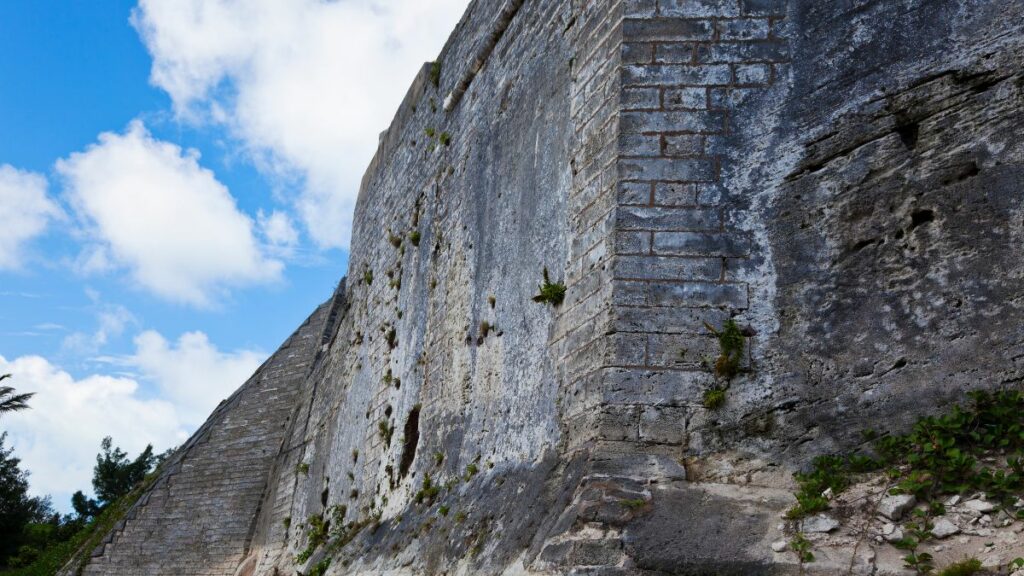
Bermuda’s historic forts are characterized by distinct architectural features that reflect their strategic defense purposes. These structures often include ramparts and substantial walls built to defend against projectiles.
The ramparts provided high vantage points for surveillance and active defense. The forts were also equipped with moats, some of which were dry.
Unlike the water-filled moats from storybooks, a dry moat is a deep trench used to hinder enemy approach and protect the walls from direct assault. Maintaining these features was essential for fortification.
Within the thick walls, soldiers managed an array of cannons.
These cannons were not merely defensive tools but also symbolized power. The positioning and number of cannons were critical in deterring potential threats and showcased the fort’s might.
Tunnels and underground passageways created hidden routes for movement and escape. These secretive pathways allowed soldiers to move undetected, resupply positions, or facilitate escapes during sieges.
Lastly, the roof structures of the forts were typically flat, allowing for additional defensive positions. Flat roofs provided space to mount weapons and offered a platform for lookouts to observe the surrounding area and sea.
| Feature | Purpose | Construction |
|---|---|---|
| Ramparts | Defense against projectiles, surveillance | High stone walls |
| Moat (Dry) | Hindering enemy approach, protecting walls | Deep trench surrounding the fort |
| Cannons | Deterrence, firepower | Strategically placed on ramparts |
| Tunnels and Passageways | Covert movement, supply, escape | Below fort; interconnected network |
| Roof | Additional defensive positions, lookouts | Flat surfaces on top of the fort |
The architectural design of these forts was imperative to their function, showcasing innovation in military architecture during their time.
Cultural and Recreational Aspects

Bermuda’s historic forts are integral in delivering a blend of cultural enrichment and recreational fun. They enrich the local traditions and offer visitors varied leisure activities.
Museums and Exhibits
Visitors can discover museums that provide a window into Bermuda’s military history and heritage at numerous forts. These include collections of artillery and exhibits on the production of Bermuda-made goods.
Notably, Fort St. Catherine houses a well-regarded museum with detailed historical displays.
- Exhibit Highlights:
- Military uniforms and artifacts
- Artillery and defense mechanisms
- Local craftsmanship and historic timelines
Picnic and Leisure Activities
Bermuda’s forts are surrounded by picturesque parks and beaches, perfect spots for picnics and leisure activities. Families can enjoy a relaxed afternoon by the ocean or engage in more active pastimes like golf or fishing.
Fort Scaur, in particular, provides an expansive green space ideal for recreational activities.
- Leisure Activities:
- Open spaces for picnics
- Trails for walking or jogging
- Access to beaches for swimming or sunbathing
Community and Events
The historical significance of these sites makes them central to community gatherings and public events.
They often serve as backdrops for cultural festivals and entertainment, with the City of Hamilton utilizing these venues for concerts and arts presentations.
These public spaces blend Bermuda’s rich past with its vibrant present.
- Event Types:
- Cultural festivals and parades
- Open-air concerts
- Art and craft exhibitions
- Event Locations:
- Fort Hamilton
- Fort St. Catherine
Location and Access

Bermuda’s historic forts are scattered across the island, providing a unique insight into the nation’s past. Accessibility varies by location, with some forts near urban centers and others in more secluded areas.
Bermuda’s Key Locations and Accessibility
Bermuda, an island nation in the North Atlantic, is well-known for its rich history and the numerous forts that are a testament to its past. The island is divided into various parishes and municipalities, each housing its pieces of history.
Dockyard: Located in Sandys Parish, the Royal Naval Dockyard is one of Bermuda’s most visited historical sites.
It is easily accessible by bus, ferry, or private vehicle. Ferries from the City of Hamilton to Dockyard are popular for visitors, offering scenic views of Hamilton Harbour.
City of Hamilton: The capital city, Pembroke Parish, is a hub connecting the island. Many forts, such as Fort Hamilton, can be found in and around the city.
Public transportation options, including buses and ferries, make access relatively straightforward.
Hamilton Harbour: Forts around Hamilton Harbour, including Paget Fort, provide a historical frame for the bustling maritime traffic of the area.
The harbor is well served by public ferries that link the surrounding parishes.
Pembroke Parish: Forts like Spanish Point Battery and Admiralty House Park are more accessible due to their proximity to Hamilton. Local buses cover the area extensively.
St. George’s Parish: Rich in history, this parish at the east end of Bermuda is home to the World Heritage Site, the Town of St. George, and nearby forts such as Fort St. Catherine.
Accessible by bus and via the nearby airport at Ferry Reach, the parish has robust visitor facilities.
Southampton: This parish is known for the Southampton Fort. Public buses serve the route along the South Road, making visiting relatively simple.
Sandys: In addition to Dockyard, Sandys Parish hosts other fortifications, such as Scaur Hill Fort. Public transportation, including the bus routes that traverse the parish, can reach these.
Paget: Home to a less dense collection of forts, Paget is centrally located and well-connected through public transportation routes between the City of Hamilton and Southampton.
Visitors looking to explore the forts within these key locations usually find that Bermuda’s size and well-established public transportation system facilitate straightforward access to historical fort locations.
Scooters are also popular among tourists for a more personal exploration of the island’s history.
Conservation and Preservation

Bermuda’s historic forts are crucial to the island’s heritage and are protected and preserved through rigorous conservation efforts.
UNESCO World Heritage Site
St. George, a historic town located in Bermuda, and its related fortifications have been designated as a UNESCO World Heritage Site, underscoring their international significance.
This status ensures that strict guidelines are followed for preserving and protecting these historical buildings. The forts, built predominantly from indigenous limestone, require consistent monitoring and maintenance to prevent deterioration.
The World Heritage Site designation has provided a framework for continued conservation efforts to retain the authenticity and integrity of these structures for future generations.
- Key measures for conservation:
- Regular assessments of structural stability.
- Periodic restoration of limestone masonry.
- Protective legislation for heritage buildings.
- Protection efforts:
- Controlled development around heritage sites.
- Public education on historical significance.
Related: 3 Magnificent Forts of Jaipur: An Odyssey Thru Times Past
Visitor Information
Visiting historic forts in Bermuda provides an opportunity to experience the island’s rich military history. The following information will assist visitors in planning their trip to these storied locations.
Admission and Hours
| Fort | Admission Fee | Opening Hours |
|---|---|---|
| Fort St. Catherine | $7 Adult | 10:00 – 16:00 daily |
| The Keep Fort | $15 Adult | 09:30 – 17:00 daily |
| Fort Hamilton | Free | 09:30 – 17:00 daily |
Children under five are typically admitted for free. Discounts are often available for seniors and may apply for children aged 5-12.
It is advisable to confirm hours before visiting, as they can vary by season or during special events.
Guided Tours and Activities
Guided tours are generally available at most forts, providing insights into each location’s unique history and attractions.
History buffs will enjoy the depth of knowledge these guides offer:
- Fort St. Catherine: Tours occur every hour and include visiting the onsite museum.
- The Keep Fort: Feature access to the National Museum of Bermuda and maritime exhibits.
- Fort Hamilton: Regularly hosts reenactments and walking tours through its moat gardens and ramparts.
Self-guided tour options are available for those who prefer to explore independently.
Activities at these forts also include live demonstrations, historical reenactment events, and interactive exhibits, providing a dynamic educational experience.

Cory is a website owner and content creator who enjoys fishing, history, coin collecting, and sports, among other hobbies. He is a husband and father of four.
Romans 15:4 For whatever was written in former days was written for our instruction, that through endurance and through the encouragement of the Scriptures we might have hope.

